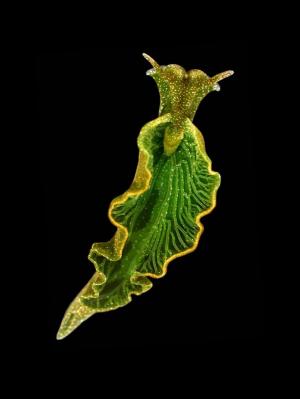I’ve been wanting to write a post about animals that share an intimate, physical association with plants. Sloths, you’ll remember, host algae inside the cells of their fur. The giant green anemone, which we hosted back at the aquarium, traps algae in its body and uses its photosynthetic energy for its own food. But I never expected this bombshell:

It’s an animal. It’s a plant. It’s half animal, half plant.
It’s Elysia chlorotica, a sea slug that generates its own chlorophyll. It doesn’t host a plant, like the sloth. It doesn’t hijack plants, like the anemone. It literally steals DNA from the algae it eats and incorporates it into its own genes. Keep the light on, and it generates its own food. It is the world’s only known photosynthetic animal. It bridges two kingdoms of organisms. It literally is what it eats.
If you’re not as amazed as I am by this, let me run that by you again: It steals DNA from another being and grafts it on to its own. It can even pass that DNA on to its offspring, ensuring that baby slugs can get their first meal from the sun, without ever taking a bite of anything. The mechanism by which it does this genetic grafting is unknown, but imagine the possibilities inherent in acquiring the properties of what you consume. What would you eat, what would you possess? Me, well… I’m a bit of an epicurean, to be sure, and I’d miss the pleasure of food, but I’d like the same power as the slug. I’d like to turn green. I think I could forgo all the meat in the world to know what it’s like to step outside, turn my face and palms to the sun, and be fully nourished in my body as I am in my soul. I’d like to eat light. I’d like to live with hunger in my skin.

July 15th, 2010 at 3:06 am
This makes me wonder what sunlight would taste like, and if there would be different flavors of it for different times of day, locations, or levels of brightness.
I bet you’d be able to pair different lights like wine and food. Gourmet restaurants would be open-air joints with impressive vistas and boutique sunscreens and colored (read: flavored) shades on the menu. Chefs would work in stained glass and plastics. Fast food shacks and convenience stores would run on light bulbs. And there would be tanning salons like Baskin Robbins.
Oh! And what if different parts of your body were sensitive to different flavors, like those old (and admittedly disproved) tongue maps? Where would you taste sweet the most, or salty, or sour?
This is a damn entertaining idea to play with. Thanks.
July 15th, 2010 at 10:44 am
In my botany days, playing with the spectrum of light was my favorite game. I’d put plants under all kinds of light gels: incandescent, fluorescent, red, far-red, yellow, green, whatever.
“Far-red,” by the way, is not quite the same as infrared, but is low-energy; it’s the filtered, reflected light a plant gets when it’s in shade. Trees have special leaves — “shade leaves” — to absorb it. I kind of imagine it as a deep, starchy base flavor.
Yellow is the color leaves are best designed to absorb, but not the only color. A plant raised in pure yellow light — or even incandescent light –gets too much of one kind of good thing. Yellow light is basically junk food: sweet, salty, oily, nutritious, but if it’s all you eat you will fall over and die.
Green, of course, will starve your plant. Fluorescent light, being white, is a balanced diet.
July 16th, 2010 at 1:39 pm
Of course, as a nice warm-blooded creature, even if you were in bright sunlight and totally tinted with chlorophyll you would starve to death. We need too many calories.
Compared to sea slugs, insects, lizards and so on, we, mammals and especially humans with our large brains, are the Americans of the animal kingdom. Look at us! So productive! So advanced! Slurping up so many calories to do it. How much less of the world would we have to cultivate if we consumed calories at the rate of a slug?
July 16th, 2010 at 7:34 pm
The solution here, obviously, is to evolve giant glider wings. Extra skin between our arms and torsos = more surface area for getting food via sunbathing. Plus we’d all want to be thin enough to base-jump.
Also, I disagree with the idea that we use this world the way we do because we have to. Cultivation is only partially about meeting survival needs. The rest of it is that we’re creative and bored and not everybody’s worrying about dying all the time. Most of it, I think, is entertainment over necessity.